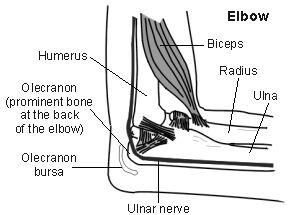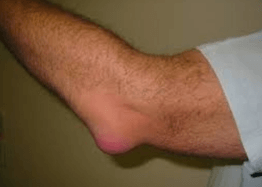What is Olecranon Bursitis?
Olecranon bursitis also called elbow bursitis, liquid elbow, or elbow bump is a condition where the bursa becomes irritated, inflamed, and filled with extra fluid hence causing a painful swelling at the tip of the elbow.

This condition has earned the nickname of student’s elbow and miner’s elbow because it is a common practice for students to rest weight on elbows during writing, hence leading to the condition.
Elbow parts
Olecranon bursa
Olecranon is the part of the elbow at the tip that is usually pointed while a bursa is a thin and slippery sac of fluid (the fluid is called synovial fluid) that runs throughout the body and provides cushion between the bone and soft tissues. The fluid reduces friction during movement.
The sac has little fluid in it and lays flat. Hence the olecranon bursa is the sac that lies between the skin and the pointy tip of the elbow and helps the skin slide over the bone smoothly.


Causes
Some of the causes are:
Trauma
This happens when one hits the back of their elbow or receives a blow, for example, falling on your back causing the elbow to be hit. This can cause swelling and can lead to the bursa having excess fluid. People vulnerable to this kind of trauma are the athletes.
Prolonged pressure
People who have a habit of constantly leaning on their elbows on hard surfaces such a table can also be a victim of this condition, after a period of time.
For example, constantly leaning on the work table while doing work puts pressure on elbow and it may cause swelling. Students, plumbers and technicians who often crawl and lean on hard surfaces using their elbows become exposed to the condition.
Infections
If one has infections at the tip of the elbow, for example after being bruised, having mosquito bites, or punctured wounds, the bacteria can also infect the bursa to cause septic bursitis. This makes the olecranon bursa to be red and swollen. Pus may also be produced if the infection is not treated.
Other medical conditions
Conditions such as rheumatoid arthritis, kidney failure, or gout are a likely cause of the condition.
Signs and Symptoms
- A patient may notice gradual swelling of the tips of the elbow, though in some cases it may be quick. At first, the swelling can go unnoticed as the skin around the pointed elbow is loose. The situation can be worse and form a soft ball-like appearance.
- The bursa can be infected and cause tenderness, redness, and warm feeling around the area and one might even experience fever. If the infection is not treated, it could spread and attack other parts of your body and become serious.
- The infected bursa can open up and drain pus due to infection.
- One can experience some pain on the elbow that increases as one presses against it. As the pain increases, it can restrict elbow motion, where one cannot bend the elbow though at times, the bursitis is not painful.

Diagnosis
A doctor can diagnose the condition by doing an X-ray to check for broken bone, calcium deposit at the elbow or bone spur. Bone spurs are usually common in patients who have a history of repeated instances of elbow bursitis.
One can have fluid removed from the elbow to test for the traces of pus, which is a positive sign for infection of the bursa.
Blood tests can be done to check for infections, gout, or rheumatoid arthritis, which can cause the condition.
Treatment
Non-surgical treatment
In case the bursa is not infected, the doctor can use a needle or syringe to remove the fluid from the elbow, this is aspiration. Then afterwards the patient is supposed to wear a tight pressure bandage to prevent the fluid from building up again.
Medication
One can be injected with steroids such as corticosteroid medication, an anti-inflammatory drug to relieve pain and the swelling. This can however have a side effect of causing infections and degeneration of the skin at the elbow.
The patient is also advised to avoid activities that irritate the area. One can apply a snug elbow wrap or elbow pads to provide cushioning to the elbows.
The patient can also take oral or topical anti-inflammatory medications such as ibuprofen, naproxen and diclofenac, which reduce swelling and relieve symptoms. Paracetamol can be used if elbow is painful.
If the bursa is infected, the patient can use antibiotics such as flucloxacillin and corythromycin, as prescribed by the doctor to fight the infections. This will also depend on the micro-organisms causing the infection, though the main micro-organism causing this condition is staphylococcus Aureus.
Self-care
This can administered by resting and compressing ice on the affected area every day to reduce the swelling and inflammation. The patient can also elevate the elbow; this reduces inflammation as it reduces blood flow to the area. Padding is also advised to keep the elbow protected.
Surgical treatment
Surgery can be done to remove the olecranon bursa if the infection persists and the medicine given does not offer treatment. This surgical process is however combined with the use of oral or intravenous antibiotics.
The bursa usually grows back as non-flamed, after the surgery in several months hence the patient should not be worried. If the elbow bursitis is not as a result of infection and the medication given does not work, surgery can also be done to remove the bursa.
It should be noted that surgery will not affect the muscle, ligament or joint structures.
After the surgery, the elbow is padded and protected using a splint. Some doctors recommend exercises such as stretches and strengthening activities to help with the healing process and restore motion and muscle tone. The skin will heal after about 10-14 days, and after 3-4 weeks, one is able to use the elbow fully.
Physicians who are experts in treating this condition include orthopedic surgeons, primary care physicians, physiatrists and sports medicine physicians.
Reference List
- Olecranon bursitis. Available at: www.assh.org/hand-arm-conditions/olecranon-bursitis
- Treatment of olecranon bursitis. Available at: orthoinfo.aaos.org/topic.cfm?topics=a00028
- Olecranon bursitis. Available at: emedicine.medscape.com/article/327951-overview
- Treatment of olecranon bursitis. Available at: www.arthritis-health.com/types/bursitis/elbow-olecranon-bursitis
